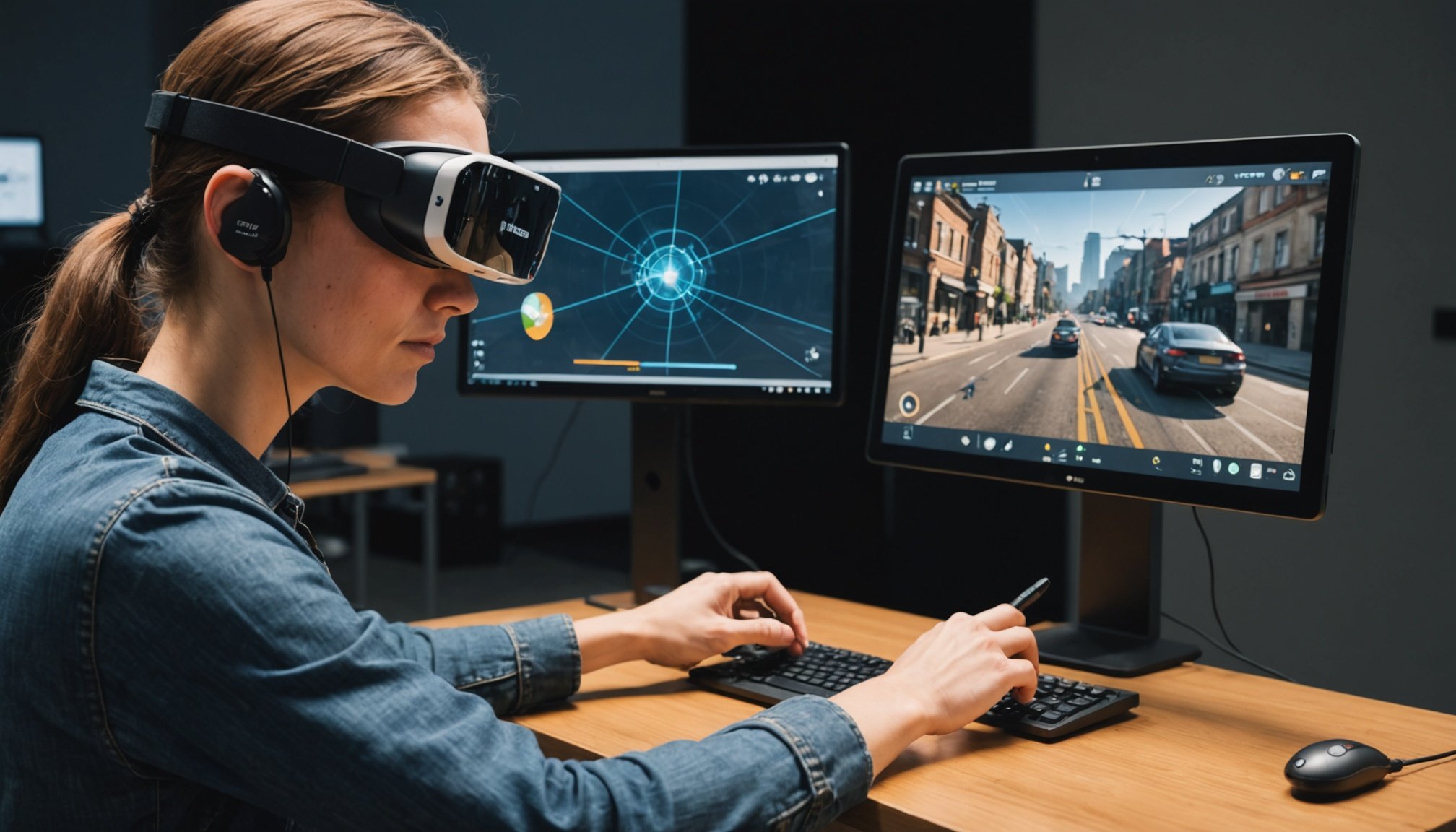Understanding Gesture Controls in Augmented Reality
Gesture controls are crucial to enhancing interaction within augmented reality environments, enabling users to engage naturally. This technology relies on sensors and cameras to interpret physical movements, translating them into commands without physical contact. The most common gestures include swipes, pinches, and taps, making it vital to design them intuitively.
The importance of intuitive design cannot be overstated, as it directly impacts user satisfaction and ease of use. By prioritising clear and straightforward gestures, developers can significantly reduce the learning curve, allowing users to engage effectively. For instance, designing gestures that mimic daily physical interactions can aid comprehension.
Also to read : Transforming Platformer Gaming: Leveraging Neural Networks to Create Smart Enemy AI
Moreover, understanding user preferences and behaviours is fundamental in refining these controls. User testing and feedback tend to reveal insights about preferred gestures and potential areas of confusion. This tailored approach helps ensure that the gesture ecosystem remains accessible to a diverse audience.
As technology evolves, developers must continue to explore innovative ways of integrating gesture controls to maintain high levels of user engagement. By keeping abreast of emerging trends and user expectations, they can refine interactions, providing users with more immersive and intuitive AR experiences.
In parallel : Unleashing the Potential of Neural Networks: Revolutionizing Real-Time Object Recognition for Augmented Reality Gaming
Principles of Intuitive Gesture Design
Creating intuitive gesture controls in augmented reality requires a thoughtful approach to gesture design principles that enhance user interface functionality. A core principle involves crafting gestures that mirror natural human movements, ensuring fluid interaction with virtual elements. Users benefit from gestures that are straightforward, allowing for seamless navigation without confusion.
Fundamental principles of intuitive controls
Designing intuitive controls necessitates a balance between user convenience and system complexity. Controls should be straightforward enough for quick learning yet sophisticated to support diverse actions. This could mean prioritising essential gestures like swipes and taps for frequent tasks while offering advanced moves for complex ones.
Visual and audio feedback mechanisms
Integrating visual and audio feedback mechanisms is crucial for affirming users’ actions within an AR environment. Feedback, such as visual cues or sound effects, provides assurance that gestures have been executed correctly, reducing uncertainty and frustration. This layer of feedback deepens user engagement by confirming their interaction results.
Contextual cues for user guidance
Ensuring users understand when and where to deploy gestures can be achieved through contextual cues. These cues, subtly embedded within the interface, guide users in navigating AR settings without overwhelming them. For instance, hints or animations can indicate appropriate gestures, enhancing clarity and user confidence.
Practical Techniques for Implementing Gesture Controls
Implementing gesture controls in game design strategies begins with understanding the unique requirements of the augmented reality environment. A step-by-step approach is crucial to ensure effective gesture implementation and to maximize user engagement. Developers should start by defining clear objectives for each gesture, considering the ease of execution and user comfort. Simple gestures can facilitate common tasks, while more complex gestures can unlock advanced features.
Tools and frameworks are essential for developing and refining gesture-based interactions in augmented reality. Developers have a variety of options, such as Unity3D or Unreal Engine, which offer robust support for gesture integration. Choosing the right tool can influence the overall game design, affecting both functionality and user experience.
Compatibility across different devices and platforms is another important consideration. Ensuring that gestures remain consistent and responsive on various hardware and operating systems prevents user frustration and broadens the potential audience for the AR game.
Successful implementation of gesture controls ultimately relies on a well-rounded approach that balances technical capabilities with user-centered design principles. By focusing on these aspects, game developers can create intuitive and engaging AR experiences.
Enhancing User Experience with Accessibility Features
Accessibility is integral to augmented reality (AR) design, ensuring all users can enjoy immersive environments. Inclusive design mandates each element, including gesture controls, be accessible to diverse user groups. Prioritizing accessibility in game design helps app developers create experiences that are both engaging and equitable.
Importance of accessibility in game design
Developers must consider the range of user abilities and environments. Adapting gestures to accommodate users with mobility challenges broadens participation and enhances satisfaction. An approach focusing on accessibility in AR not only respects users’ needs but also expands market reach.
Techniques for making gesture controls accessible
To make gesture controls inclusive, developers can implement adaptive algorithms that modify the sensitivity of gestures, ensuring all users can interact smoothly. This might involve customizing gestures or offering alternative interaction methods for those with physical limitations.
Testing methods to ensure user inclusiveness
Testing with diverse user groups uncovers potential barriers and validates inclusive design efforts. Engaging feedback from these groups can inform iterative design improvements, ensuring optimal accessibility. By addressing these aspects, developers foster a more comprehensive user experience, bridging gaps and inviting participation from all demographics. Through thoughtful design, AR can be accessible for everyone.
Case Studies of Successful AR Games
Exploring case studies of successful AR games highlights how effectively implemented gesture controls can significantly boost user engagement. These games illustrate various design strategies that maximise the potential of gesture controls.
Pokémon GO brilliantly incorporates gesture controls to enable intuitive interactions, such as swiping to throw Poké Balls. This design choice simplifies gameplay, keeping it accessible yet engaging. Similarly, Harry Potter: Wizards Unite utilises complex gestures for spell casting, providing a balance between accessibility and depth, which broadens its appeal.
Successful AR games often share certain design characteristics:
- Intuitive and clear gesture implementation: This ensures that players can easily understand and perform actions.
- Feedback-rich environments: Users receive immediate responses to their gestures, enhancing immersion.
- Strong focus on user engagement: Games remain captivating through a mix of straightforward and challenging gestures.
Learning from these case studies, developers should prioritise user-centric design, understanding that well-crafted gestures can bridge the gap between the digital and physical worlds, enhancing the overall gaming experience. By analysing these successful examples, developers can integrate best practices into their AR projects, creating more immersive and enjoyable experiences for users.
Challenges and Future Directions in Gesture Control
Exploring the gesture control challenges within augmented reality (AR) unveils several complexities developers must navigate. A primary obstacle is ensuring accuracy across diverse environments and user behaviours. Recognition errors are common, particularly in dynamic settings or when user movements are unconventional. To combat this, leveraging advanced algorithms is vital for precise interpretation.
Emerging technologies continue to reshape AR gesture design. Artificial Intelligence (AI) is playing a transformative role by boosting accuracy and adapting to user nuances. AI enables real-time learning from user interactions, resulting in more responsive gesture controls. Additionally, machine learning refines the system’s ability to detect subtle gestures, accommodating varied execution styles.
As we look to the future of gesture-based interaction, evolving preferences demand smarter interfaces. Anticipating trends means recognising the influence of haptic technology on user feedback mechanisms, potentially incorporating tactile sensations into AR for enhanced immersion. Future innovations also hinge on improving gesture intuitiveness, striving for controls that feel intuitive and require minimal effort.
Lastly, forward-thinking strategies must prioritise continuous user engagement through adaptive systems and personalised experiences. By embracing these directions and integrating cutting-edge solutions, developers can offer increasingly compelling and user-friendly AR interfaces.











